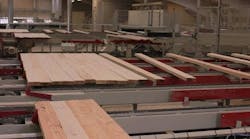When Dansk Træemballage A/S (DTE) looked at how to increase the precision and productivity of its sawmill, one of the major challenges was to establish the right automation-control network. As the biggest producer of wooden packaging in Denmark, the plant uses more than 100 inverter drives, all of which needed to be controlled simultaneously and in real-time. The technology used to address this challenge was CC-Link IE.
Every day, approximately 35 trucks bring conifer logs to the saw line to produce lumber, resulting in more than 300,000 m3 of raw timber being processed annually. This lumber is then exported or distributed across DTE’s five production sites to obtain 150,000 m3 of finished wood that is used to assemble crates and pallets.
The sawmill comprises a number of stations, which turn logs into rough-cut timber (and eventually finished lumber) by performing debarking, profile-cutting, sawing, sorting and stacking activities. All these stages require high-quality, reliable and responsive inverter drives to correctly position and power processing equipment such as grinding rolls and saw blades.
“Running a sawmill means continuously improving the speed and productivity to get the most out of the raw materials. A quality finish is also particularly important for DTE, as we mainly focus on the food industry, which has strict standards on the end quality of the crates and pallets,” said Orla Poulsen, DTE owner.
An interconnected and responsive mill
To keep operations smooth and efficient, DTE needed a communication-network technology able to connect the inverters to PLCs and ensure that the machines could instantly adjust their parameters for optimal performance. Thus, the company appointed Hans Folsgaard as its technical partner to upgrade the plant automation system. Carsten Olesen, technical manager at Hans Folsgaard, explained, “Accuracy is fundamental. This is why DTE asked us to find a fast network technology.”
And the choice of which network solution to use was immediate for Hans Folsgaard—the team selected the ethernet technology with the largest bandwidth available; CC-Link IE, which provides data transfer rates of 1 Gbps for high-speed communications. Also, by offering a maximum of 254 stations per network, the solution could accommodate all the variable frequency drives across the saw line as well as supporting future growth.
“CC-Link IE is the world’s first and only open Gigabit Ethernet for automation,” explained Tim Lomax, director of the CC-Link Partner Association-Americas (CLPA-A). “As such it offers higher performance capabilities than any other industrial ethernet. DTE is using CC-Link IE to build a very large network of inverters that operate this sawmill. The result is higher productivity and increased business competitiveness as quality and output both rise, without changing the mechanical aspects of the plant machinery.
Lomax noted the importance of DTE getting the maximum yield out of each log. “The benefit that the high-speed response time and bandwidth that gigabit ethernet offers is that the machines on the saw line can assess the dimensions of each log as it goes through the mill in real-time. In this way, DTE is able to very accurately measure each log and can make the most use of its raw materials.”



